Commentary &repeated posts 20 Aug 2011 07:11 am
Iwerks Recap
This is a piece I originally wrote in October 2006 for this blog. I wanted to reprise it given the amount of attention I’d given Iwerks lately re Tim Susanin‘s book, Walt Before Mickey, and the Iwerks multiplane camera.
- From my earliest days, as soon as I’d learned who he was, I was a fan of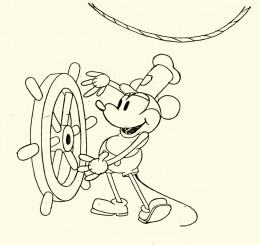 Ub Iwerks.
Ub Iwerks.
I began to wonder if it was just the publicity and myth of Iwerks which had followed with him all these years. We read about all those 1930′s East coast animators moving to the West, not to work for Disney but to seek out Iwerks – it was well known that he was the “true artist” behind those Disney shorts.
With Bob Thomas’ 1958 book, The Art of Animation, I read, for the first time, about Iwerks and his importance. Only recently did I begin to wonder how responsible Iwerks actually was to Disney’s success. Was this just that myth being carried over the years? Or was he brilliant?
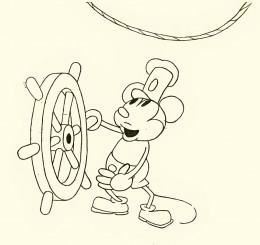 A quick look at the animation done at the time and we see some basics not yet developed.
A quick look at the animation done at the time and we see some basics not yet developed.
There weren’t many stories written before Disney, so animators divided up their pictures. For example: They’d decide to do a film where Mutt & Jeff would go to Hawaii. One animator would start on the beach and end with them on surfboards. The animator would make it up as he went along until he turned out the required footage – maybe 2 minutes of work. The next animator would pick up Mutt & Jeff on surfboards and take them to being washed up on the beach, etc.
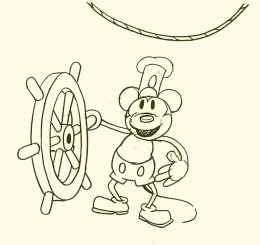 Obviously, the lead animator doled out rudimentary plot points, but a lot was left to the individual animator. Look at the book, Walt In Wonderland by Russell Merritt & J.B. Kaufman to see how Disney started developing stories during this period.
Obviously, the lead animator doled out rudimentary plot points, but a lot was left to the individual animator. Look at the book, Walt In Wonderland by Russell Merritt & J.B. Kaufman to see how Disney started developing stories during this period.
The same was true for animation techniques and methods. Animation burst out of its seams with the creation of Mickey Mouse. Disney had initiated a lot of ground work, but the medium really started growing with the enormous success of Steamboat Willie. Iwerks led the way, not only by the amount of work he did but the quality.
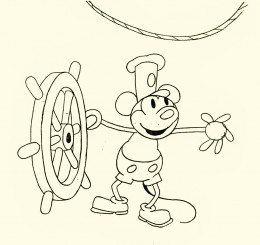 Take a look at these five Iwerks drawings from that short.
Take a look at these five Iwerks drawings from that short.
One of the first lessons an inbetweener learns is that a face turn shouldn’t have a direct middle in it. The middle drawing (#3 here) shouldn’t be straight on; it should favor, slightly, one side or the other.
Despite the simple drawings of Mickey, Ub Iwerks seemed to understand this instinctively. He didn’t really get lessons from anyone. As a matter of fact, he was creating the rules. This comes close to being straight on, but the mouth gives it away. The face is facing screen left.
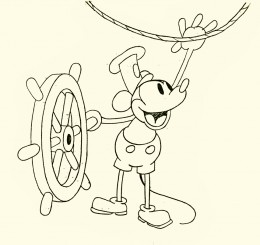 Another simple inbetween lesson is to offset the inbetween (usually an animator or good assistant will set this up for the inbetweener.)
Another simple inbetween lesson is to offset the inbetween (usually an animator or good assistant will set this up for the inbetweener.)
Here Mickey is standing upright on #1 and he’s upright on #5. Drawing #3 has him with knees bent, beating in tempo to the sound. Even though this is from the first sound cartoon, done in 1928, the offset rule is in effect.
I think it’s pretty clear that some sophistication has entered the animation that Iwerks was drawing. This same sophistication isn’t in other animator’s work.
(Click any image to enlarge.)
Add to this the fact that Iwerks was probably the fastest producing animator, and you probably have good reason for knowing he was the genius behind Disney.
This, of course, didn’t remain that way. After Iwerks left, leaving behind enough animators trained by him, their work developed exponentially. Better artists were entering the studio and bringing their talents to the work, and they started making a serious attempt to improve the work.
Iwerks stopped animating and stopped trying to improve the character animation. Instead, he tried to improve the camera – actually developing the mulitplane camera in his own studio. Animation, under Iwerks, didn’t develop.
The book by Leslie Iwerks & John Kenworthy, The Hand Behind The Mouse, gives some solid information that wasn’t previously published and puts a lot of material into perspective.
Now we have Walt Before Mickey: Disney’s Early Years 1919-1928. by Tim Susanin. This is a thoroughly researched and reliably accurate book which gives a good account of Iwerks’ contribution up to and including Plane Crazy.

on 20 Aug 2011 at 11:26 am 1.Marc said …
You can absolutely have an in-between that is directly in between two drawings–so long as you’re focused on inbetweening the FORM, and not just the LINE. That is the bog mistake most novice inbetweeners make.
on 20 Aug 2011 at 11:27 am 2.Marc said …
That’s “big” mistake…
on 20 Aug 2011 at 11:55 am 3.Michael said …
Art Babbitt taught me that you didn’t draw a face straight on. This is the obvious coice of the poor/mechanical inbetweener. The head should be slightly to the left or to the right or slightly up or down, depending on the action.
on 21 Aug 2011 at 12:28 pm 4.Steve Segal said …
Didn’t Leslie Iwerks write The Hand Behind The Mouse with John Kenworthy?
on 21 Aug 2011 at 12:56 pm 5.Michael said …
Yes, of course Leslie co-authored the book with John. I’ve corrected it in my post.